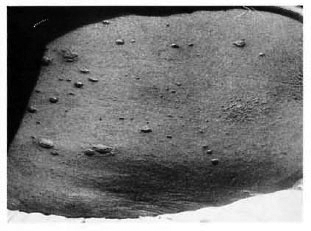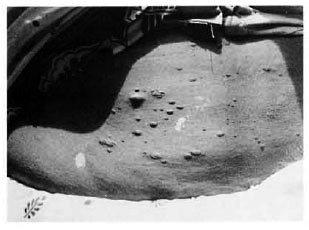- Volume 62 , Number 2
- Page: 297–8
Pefloxacin in histoid leprosy
To the Editor:
A 26-year-old female was diagnosed as having leprosy 6 months ago and was put on antileprosy treatment. She developed shiny nodular lesions over the body whileon treatment. When she was first seen by us she had well demarcated, shiny, papular and nodular, nontender lesions over the face, extensors of the forearms, back and abdomen (Fig. 1). The surrounding skin was apparently unaffected. All of the nerves of predilection were thick but not tender. She was diagnosed clinically as a case of histoid leprosy and was investigated accordingly. Her bacterial index (BI) was 6 + , morphological index (MI) was 10%, and skin biopsy revealed features of histoid leprosy. Routine investigations were within normal limits.

Fig. 1. Histoid lesions over the abdomen before treatment.
She was put on pefloxacin 400 mg BID for a period of 8 weeks in addition to WHO-MDT. She tolerated the drugs well, but there was no clinical improvement (Fig. 2). Her BI remained 6+ as expected but even the MI did not fall to 0; it was 2%. Another skin biopsy showed the same features. (Facilities for other investigation such as mouse foot pad inoculation are not available to us.)

Fig. 2. Histoid lesions over the abdomen after 8 weeks of pefloxacin treatment.
A study by Grosset, et al. (1) showed marked clinical improvement in patients with nodular lepromatous leprosy on treatment with pefloxacin for 8 weeks. For practical purposes, a histoid lesion is an unusually active leproma and the histoid features are lost as soon as the lesion starts to regress (2). Compared to this, our patient with histoid features did not respond at all clinically, bacteriologically or histologically to treatment with pefloxacin or WHO-MDT.
Does the histoid variety of leprosy differ from other nodular lepromatous leprosy with respect to the response to treatment with newer antileprosy drugs like pefloxacin? We wish to share the experiences of other workers with pefloxacin treatment in histoid leprosy and the possible pathogenesis of the response.
- P. M. Mahajan, M.D.
Visiting Dermatologist
- V. H. Jadhav, M.D.
Visiting Der nlatologist
- J. M. Mehta, M.B.B.S.
Hon. President
Poona District Leprosy Committee
35 "Manisha," 2A Moledina Road
Pune 411001. India
REFERENCES
1. GROSSET, J.-H., JI, B., GUELPA-LAURAS, C. -C, PERANI, E. G. and N'DELI, L. N . Clinical trial of pefloxacin and ofloxacin in the treatment of lepromatous leprosy. Int. J. Lepr. 58 (1990) 281-295.
2. RIDLEY, D. S. and JOB, C. K. The pathology of leprosy. In: Leprosy. 1st edn. Hastings, R. C, cd. Edinburgh: Churchill Livingstone, 1985, pp. 100-133.
Reprint requests to Dr. Mehta.